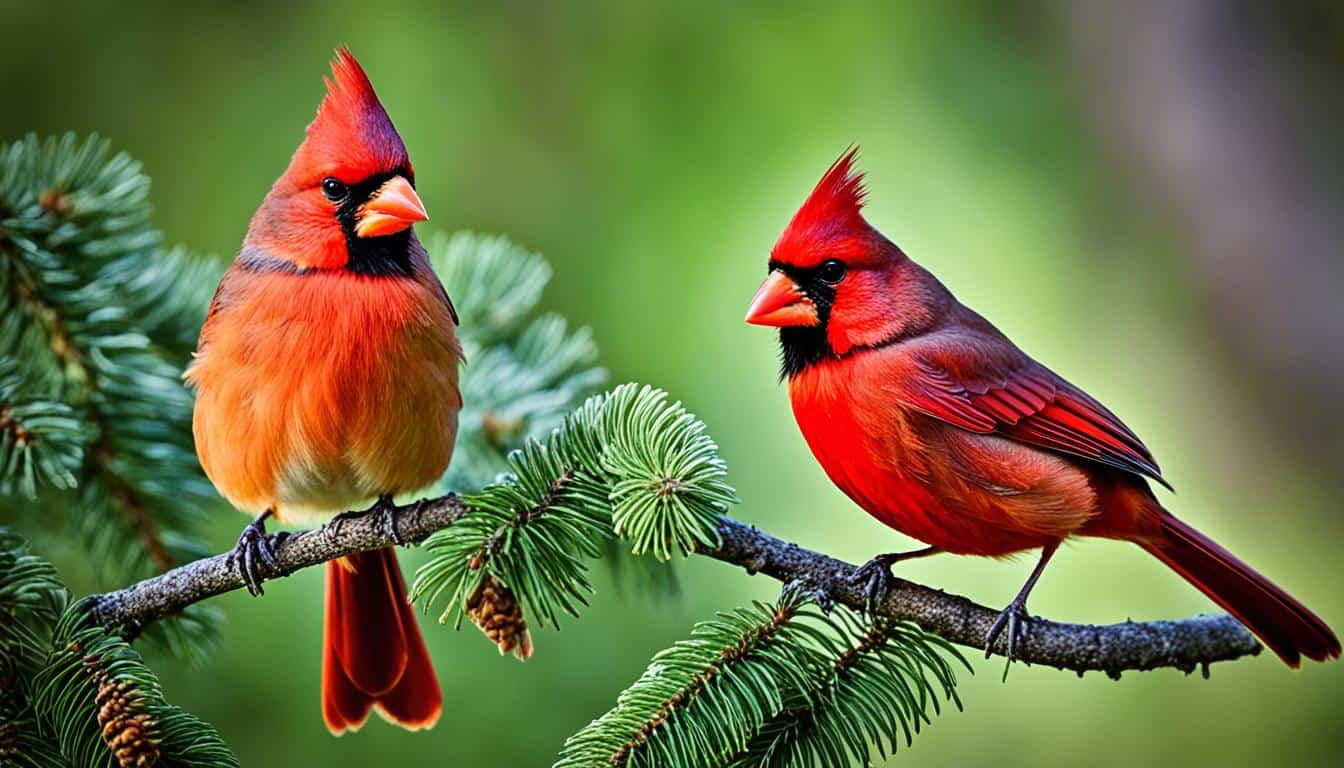Do Cardinals Mate for Life? Bird Love Explained
Ever curious to know how Do Cardinals Mate for Life? These bright red birds are famous for staying together for life. But is it really true they mate for life? Let’s dive into their love story, from courtship to their strong bond.
Cardinals are known for being faithful to each other, often staying together all year. They return to the same spot every spring. Their loyalty shows how strong their love is. But what keeps them together, and how do they keep their relationship strong?
Close Bonds: Cardinals Mate for Life
Northern cardinal pairs often keep strong, lifelong bonds. Many stay together all year. These vibrant red birds show amazing cardinal pair bonding and cardinal nesting behaviors. These help their relationships last.
Do Cardinals Stay Together All Year Long?
Some cardinal pairs may go their separate ways after breeding. But, many northern cardinals prefer to stay together all year. They only leave their territory to join bigger winter flocks. Yet, they stay true to each other, showing cardinal courtship behaviors and defending their territory.
Courtship Rituals and Communication
During courtship, male cardinals show off by feeding their mates and engaging in beak-to-beak actions. These actions strengthen the pair’s bond and get them ready for breeding. Cardinals also talk to each other with their unique songs. Males sing more aggressively to protect their territory, while females use more complex songs.
“The male cardinal’s brilliant red plumage and melodious song make him one of the most recognized backyard birds in North America.”
| Cardinal Courtship Behaviors | Cardinal Pair Bonding | Cardinal Nesting |
|---|---|---|
| Male cardinals feed their mates | Pairs often stay together year-round | Pairs work together to build nests |
| Beak-to-beak interactions | Defend shared territory | Both parents care for the young |
| Aggressive male songs | Females use elaborate vocalizations | Nests are well-camouflaged |
How Long Do Cardinals Live?
Cardinals live longer than many songbirds, thanks to their bright red color. They can live from 3 to 5 years in the wild. Some may even reach up to 15 years old.
Cardinals live a long time because they don’t migrate. Birds that stay in one place tend to live longer. They also live in high places and are careful, which helps them live longer.
Lifespan of Cardinals
In the wild, cardinals usually live 3-5 years. But, some can live up to 15 years in captivity. Their lifespan depends on many things, like:
- Habitat and environment
- Access to food and water resources
- Predation risk
- Health and disease factors
The cardinal lifespan shows how tough and adaptable they are. This makes them interesting to birdwatchers and nature lovers.
“Cardinals are known for their long lifespans, often outliving many other songbird species in the wild.”
Cardinals’ Mating Habits
If you’re interested in cardinal birds, their mating habits are fascinating. These birds are known for being monogamous, staying with one partner for life. The male cardinal plays a key role in building the nest and keeping the eggs warm.
Cardinals are very loyal to each other. Most pairs stay together forever. But, if one bird dies, the other will find a new mate to keep their species going.
The way cardinals reproduce shows their strong bond. When the female builds the nest, the male helps by bringing materials and shaping the nest. After the nest is ready, the female lays 2-5 eggs. Both parents take turns keeping the eggs warm.
The male cardinal doesn’t stop helping after the eggs are laid. He brings food to the female and watches over the nest. When the eggs hatch, both parents feed and care for the young until they can fly on their own.
Cardinals have beautiful courtship rituals and stay together for life. Their love and dedication show us the beauty of cardinal reproduction and cardinals nesting.
Attracting Cardinals to Your Backyard
Bringing the vibrant and beloved cardinal birds to your backyard is a delightful prospect for many nature enthusiasts. To attract these charismatic feathered friends, it’s essential to provide the right cardinal bird feeders and the cardinal food preferences they crave.
Providing the Right Food and Feeders
Cardinals are omnivorous birds, enjoying a mix of seeds, nuts, berries, and insects. To make your backyard appealing, offer high-quality birdseed, suet, and fresh fruit. Place feeders in sheltered spots to protect them from predators and the elements.
Choose feeders that fit their large, conical beaks. Tube feeders, hopper feeders, and platform feeders are great for attracting cardinals.
“Providing the right food and feeders is the key to creating a welcoming environment for cardinals in your backyard.”
By meeting their food and habitat needs, you can attract these stunning birds. With some planning and the right setup, you’ll become a magnet for these charming guests.
Interesting Facts About Cardinal Birds
Cardinals are known for their bright red feathers and are common in North America. But there’s more to these birds than their looks. Let’s dive into some interesting facts about them.
Origins of the Name “Cardinal”
The name “cardinal” comes from the red robes of Roman Catholic cardinals. The male cardinal’s red color comes from carotenoids in their food. These pigments make their feathers stand out.
Feather Color and Diet
The male cardinal’s bright red feathers come from carotenoids in their diet. They eat many seeds, nuts, berries, and insects. This varied diet helps make them so colorful.
Omnivorous Eating Habits
Cardinals eat both plants and animals, making them omnivores. They mainly eat seeds, fruits, and nuts but also hunt insects and small animals. This flexible diet helps them live in different places.
Cardinals often do something called “anting.” They cover themselves in ants to get rid of lice and other pests. This behavior shows how unique and interesting they are to watch.
Do Cardinals Mate for Life?
Yes, cardinals are known to be monogamous birds that often mate for life. These vibrant red birds form strong pair bonds. The male and female work together to build a nest, incubate eggs, and care for their young. While some cardinal pairs do break up or find new mates, especially if one partner dies, most birds maintain lifelong partnerships.
The close cardinal pair bonding is a key part of their breeding and nesting behavior. Both the male and female cardinals contribute to nest-building. They take turns sitting on the eggs during incubation and feeding their hatchlings. This shared responsibility strengthens the bond between the mated pair, helping to ensure the successful rearing of their offspring.
“Cardinals mate for life, and the bond between the male and female is very strong. They work together as a team to raise their young.”
Even outside of the breeding season, cardinal pairs often remain together. They forage and roost side by side. This lifelong commitment to their partner is a remarkable trait. By understanding the do cardinals mate for life behavior, we can appreciate the unique and fascinating nature of these beloved backyard birds.

Cardinal Bird Behavior
Cardinals have behaviors that are both interesting and important for their survival and breeding. They are known for their territorial nature and the clear differences in looks between males and females. These traits are what make them stand out to birdwatchers and nature lovers.
Territorial Nature
Cardinals are very protective of their territory. Males will fight off any intruders to protect their mates and young. They can even attack their own reflections, thinking they’re rivals. This shows how important cardinal territorial behavior is for their safety.
Dimorphism in Appearance
Cardinals show a big difference in how males and females look, known as cardinal dimorphism. The male has bright red feathers, a bold crest, and a striking beak. The female has reddish-brown feathers. This male vs female cardinal appearance helps in their mating rituals.
The way cardinals act and look is truly captivating. Their territorial and dimorphic traits make them popular among birdwatchers and nature fans. Learning about these traits helps us understand these beautiful birds better.
Cardinal Bird Flocks in Winter
As winter comes, cardinal birds gather in large groups, adding vibrant red to snowy yards. These cardinal winter flocks can have over 70 birds together. It’s a beautiful sight.
This cardinal flock behavior is very useful. With less food around, they hunt better together. This way, they can survive the cold weather.
Watching a big group of these red birds is a treat for bird lovers and nature fans. Their bright colors stand out against the snow. It makes winter more beautiful.
“Seeing a large flock of these vibrant red birds brightens up many snowy backyards during the winter season.”
If you like birds or just enjoy nature, learning about cardinal winter flocks is interesting. It helps you appreciate these amazing birds more. You’ll understand how they work together and why these flocks are important in winter.
Cardinal Bird Subspecies and Distribution
The northern cardinal is a favorite among backyard birds in North America. It has 19 recognized subspecies, each with its own unique look. These variations show the amazing diversity within the cardinal family.
These subspecies live in different parts of the continent. You can find them from the eastern United States to Canada and Mexico. This wide range makes the cardinal a common sight for bird lovers and nature fans.
- The most common subspecies is the Cardinalis cardinalis cardinalis. It lives in the eastern United States and parts of Canada.
- The Cardinalis cardinalis floridanus is only in Florida. It’s smaller and has brighter red feathers.
- The Cardinalis cardinalis superbus lives in the southwestern United States and northern Mexico. It includes Arizona, New Mexico, and parts of northern Mexico.
- The Cardinalis cardinalis yucatanicus is in the Yucatan Peninsula of Mexico. It stands out with its deep red feathers.
The wide spread of cardinal subspecies shows how adaptable and strong they are. They can live in many different places across their cardinal geographic range. This variety makes these cardinal bird subspecies even more interesting and loved.
“The cardinal is a true ambassador of the natural world, bringing vibrant color and joyful song to the landscapes it inhabits.”
Male vs. Female Cardinal Song Patterns
Cardinal birds have a clear difference in their songs. Males sing a strong, territorial song. This song is like “cheer-cheer-cheer” or “whit-chew-chew-chew.” It helps the male defend his territory and find a mate.
The female cardinal sings differently. Her songs are softer and more complex. They are often low, warbling notes or short chirps. These songs help her communicate or get her mate’s attention.
| Male Cardinal Song | Female Cardinal Song |
|---|---|
| Aggressive, territorial calls | Elaborate, varied melodies |
| Robust, whistling tunes | Softer, more complex songs |
| Cheer-cheer-cheer or whit-chew-chew-chew | Low, warbling notes or short, sweet chirps |
| Primarily used for territorial defense | Often used to communicate needs or attract mates |
The male cardinal song and female cardinal song are key to their mating and breeding. Knowing the differences in their cardinal vocalizations helps us appreciate their complex communication.
“The male cardinal’s song is a bold declaration of his territory, while the female’s melody is a gentle invitation to her mate.”
Read My Previous Articles
| Cardinal Spiritual Meaning |
| Fun Facts About Northern Cardinal |
| Male vs Female Cardinals (5 Major Differences) |
| Cardinals Appear When Angels Are Near |
| Birds Fighting or Mating: How to Tell the Difference |
Wrapping Up on Do Cardinals Mate for Life
The cardinal bird is a fascinating creature that captures the hearts of birdwatchers and nature lovers. They stand out with their bright red feathers and strong pair bonds. Their unique songs and behaviors offer a glimpse into the amazing world of birds.
Whether you’re an expert or new to birdwatching, learning about cardinals can make your connection to them stronger. They play a big role in ecosystems and have a special place in many cultures. Each part of their life is interesting and worth learning about.
Appreciating cardinal birds can make your outdoor time better and help protect these important birds. So, take the chance to watch, learn, and admire the cardinal bird. Your backyard will be great.







